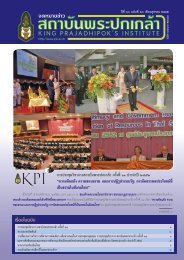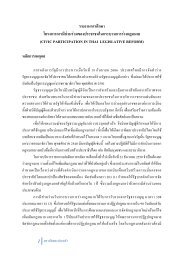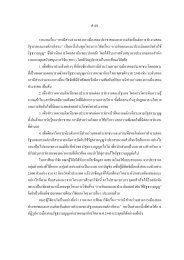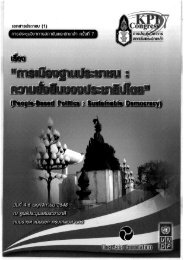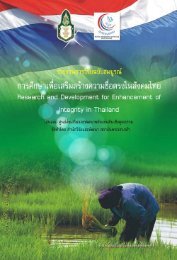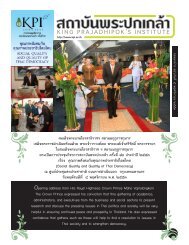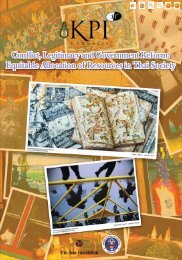SUFFiciENcy EcONOMy ANd GRASSROOtS DEvElOPMENt
SUFFiciENcy EcONOMy ANd GRASSROOtS DEvElOPMENt
SUFFiciENcy EcONOMy ANd GRASSROOtS DEvElOPMENt
Create successful ePaper yourself
Turn your PDF publications into a flip-book with our unique Google optimized e-Paper software.
204<br />
The Meaning of Sufficiency Economy <br />
International Conference<br />
shampoo, body cream, herbal medicine, mosquito repellant, herbal tea, snacks and<br />
clothing material can be produced using raw materials from the network. By using<br />
the local product, it can be expected that Inpaeng members can save a certain<br />
amount of money.<br />
In conclusion, several dimensions to describe the “survival” domain of social<br />
capital were investigated in the Inpaeng network. The competency to survive from<br />
financial threats, in that context, consists of having food security, establishing one’s<br />
welfare and the ability to produce household groceries.<br />
Sufficiency<br />
Sufficiency is the second domain of Inpaeng social capital, explored in this<br />
research. Sufficiency is the idea of promoting a balanced, moderate, wisdom-driven<br />
lifestyle. It is the counterpart of consumption based on greed and a money-driven<br />
way of life. The Inpaeng suggested that members change their points of view, aims<br />
of life, and values of living before changing their behaviour. An Inpaeng leader<br />
expressed the Inpaeng way of training their members as follows:<br />
“Plant the (ideas into the) man, before the trees.”<br />
Inpaeng members were given the big picture of how capitalism and<br />
consumerism leads to the collapse of communities. However, people cannot live in a<br />
primitive lifestyle that depends heavily on the fertility of soil and the abundance of<br />
natural resources. A new paradigm that appreciates the ancient wisdom of sharing,<br />
compassion and respect for Mother Nature, while adopting modern concepts of<br />
networking, empowering and resource managing is needed.<br />
The characteristics of the Sufficiency domain were explored in two aspects.<br />
The first aspect considered process in one’s mind. This aspect involved mindfulness<br />
and the five precepts of practicing. The outcome of those qualities of mind is<br />
expressed and explored in the second aspect which is the household financial<br />
management.<br />
Sufficiency, for the first aspect, is the consonant idea with the Buddhist<br />
sermons. The “unimpeachable path”, suggested in the Buddhist Canon, reveals three<br />
practices that will lead to a peaceful and useful stage of life. Those practices are <br />
1. control of the senses (Pali: Indriya-samvara, Thai: อินทรียสังวร) 2.moderation in<br />
eating (Pali: Bhojane-mattannuta, Thai: โภชเนมัตตัญญุตา) and 3. practice of wakefulness<br />
(Pali: Jagriyanuyoga, Thai: ชาคริยานุโยค)(พระพรหมคุณาภรณ์ (ป.อ.ปยุตโต)). In short, to<br />
develop the sufficient lifestyle, one should “know” and “control” desires. <br />
It can be claimed that the notion of mindfulness is common and well-known<br />
for Thai rural farmers, particularly around Inpaeng network area; Sakonnakhon. The<br />
area is known by the Thai Buddhists as “the cradle of the enlighten monks”. Tropical<br />
forests surround the province of Sakonnakhon were the areas that Venerable<br />
AjaanMun (1870-1949), the monk who established the ascetic forest monk tradition,



